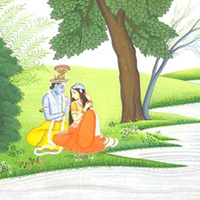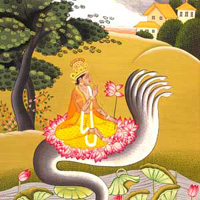| Miniatures |
 |
The essence of the Indian miniaturists' visual expression lay in the idea of symbolism. In the language of symbols they recorded their communion with nature, rich in wonder, awe and delight. Their minds excelled in expressing what lay beyond the primary function of lines and pigments.'The master painter disposes', Buddha once remarked while alluding to the art of metaphysical teaching, 'his colours for the sake of a picture that can not be seen in the colours themselves.'
Painters delighted in unfolding the other dimension of the object; the basic shift in emphasis was from the multiplicity of sense experiences to unifying ideas, from the mutable aspect to an ever-present situation. |
 |
Subjects derived from myths served as the base for such a transformation of nature into art, to reveal aspects of existence, human and supernatural or divine.
Indian miniature painting is a 'visual chamber music' to be savoured slowly, intently and privately. 'Miniature' generally refers to a painting or illumination, small in size meticulous in detail and delicate in brushwork. The art of palm-leaf illuminations were traditionally labelled as patra-lekhana in medieval Indian canons. But later a generalised term pata chitra was conviniently used to define other kinds of painting than wall painting. It indeed included painted scrolls and panels.
|
Yet these paintings are not detached visions of artistic expression but provide the basis of Indian music and art forms. Most of these masterly works are visual creations of emotional and perceptive concepts that depict the ragas or musical modes of Indian classical music. Miniature painters employed at various medieval courts, discovered the potential of limitless self-expression in their depiction and today there are 130 known sets of such miniatures.
These pictorially articulate visions of art first made their appearance in the Indian cultural scene in the 5th century. The artist drew his inspiration from a musical text called Narada Shiksha. But while the text dates back to the early beginnings of art, its artistic depiction did not gain credence till about a hundred years later, when artists and painters took cognizance of the relationship that governs sound and sentiment. This art form soon generated into a dynamic movement, fanned by patronage and fulfilled itself into figurative and pastoral scenes, making music the subject matter of art, through colour and mood.
|
 |
These beautiful paintings also depict the court life of the time when they were created. The raiment of the figures, the architecture of the land, the features of the faces come into sharp focus under the painter's lyrical eye. The thematic stance has given the works a certain uniformity, a decided formalism and a feel of the glory and grandeur of the times. The gossamer-veiled women with pinched noses, doe-eyes and graceful stances are not just an art form, but become a basis for appreciating the charm of a bygone era.
Yet within this uniform diffusion of compositional selection, there are distinct differences.
|
| These are due to the different schools of art. The Persian influence upon the Indian folk, or the workmanship of one court artist or another, have given this trove of paintings a varied content. The schools of Mewar or Udaipur or Jaipur in Rajasthan have incorporated their desert landscape and architecture. The hill kingdoms of Kumaon and Kangra are marked by fine drawing, while the plateau regions of Malwa and Bundelkhand specialize in attractive brush work. The crowning glory of the miniature series is the Provincial Mughal works, attributed to the reign of emperors Akbar and Jehangir. These depict the rulers themselves as well as historical personages and musicians. The Tanjore paintings of the South depict Krishna and Shiva and reflect the mythical source of music.
|
|
|
| Featured Paintings Gallery - Madhubani |
|
|
|
